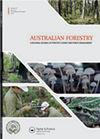Post-harvesting glyphosate and imazapyr application on Eucalyptus stumps to control coppice
IF 0.9
4区 农林科学
Q3 FORESTRY
引用次数: 0
Abstract
ABSTRACT The objective of this research was to assess the efficiency of applying glyphosate and imazapyr to Eucalyptus cut-stump surfaces after harvesting to control sprouting. Two experiments were conducted in Eucalyptus grandis × Eucalyptus urophylla plantations arranged in a randomised block design with five treatments and five replicates. In experiment 1, 0, 0.84, 1.67, 2.50 and 3.34 kg of acid equivalent (a.e.) ha−1 of glyphosate was applied. Experiment 2 involved the application of 0, 0.028, 0.083, 0.140 and 0.195 kg a.e. ha−1 of imazapyr. The application was carried out between 42 and 48 hours after harvesting in replicates of 36 stumps. Increased glyphosate doses increased coppice control to more than 90%. Coppice was present on approximately 30% of the stumps treated with the highest glyphosate dose. However, these shoots showed low vigour 225 days after application, with mean values of about 0.30 m in height and 0.5 shoots per stump. In the control treatment, coppice reached 3.0 m in height and 8.0 kg green mass weight, and coppice was present on 97% of the stumps. The highest imazapyr doses increased shoot control to 80%. Post-harvesting application to cut stumps reduced coppice development. However, only the glyphosate doses of 2.50 and 3.34 kg a.e. ha−1 presented satisfactory coppice control levels without follow-up operations.采后在桉树树桩上施用草甘膦和吡虫啉防治灌木林
摘要本研究的目的是评估在桉树采伐后的树桩表面施用草甘膦和伊沙吡以控制发芽的效率。在巨桉×尾叶桉人工林中进行了两个试验,采用随机区组设计,共有五个处理和五个重复。在实验1中,施用了0、0.84、1.67、2.50和3.34 kg酸当量(a.e.)ha−1的草甘膦。实验2涉及施用0、0.028、0.083、0.140和0.195 kg a.e.ha−1的伊玛扎吡。在收获后42至48小时之间,对36个树桩进行重复施用。草甘膦剂量的增加使矮林控制增加到90%以上。用最高草甘膦剂量处理的树桩中,约有30%存在铜。然而,这些枝条在施用225天后表现出低活力,平均高度约为0.30米,每个树桩有0.5个枝条。在对照处理中,矮林高度达到3.0米,绿色质量达到8.0公斤,97%的树桩上都有矮林。最高剂量的imazapyr将射毒控制提高到80%。采伐后应用于切割树桩减少了矮林的发育。然而,只有2.50和3.34 kg a.e.ha−1的草甘膦剂量在没有后续操作的情况下呈现出令人满意的矮林控制水平。
本文章由计算机程序翻译,如有差异,请以英文原文为准。
求助全文
约1分钟内获得全文
求助全文
来源期刊

Australian Forestry
FORESTRY-
CiteScore
3.70
自引率
4.80%
发文量
15
审稿时长
>12 weeks
期刊介绍:
Australian Forestry is published by Taylor & Francis for the Institute of Foresters of Australia (IFA) for scientific, technical, and professional communication relating to forestry in the Asia Pacific.
 求助内容:
求助内容: 应助结果提醒方式:
应助结果提醒方式:


